Buying heat tolerant plants
It was the Californian Humming Bird Trumpets that stood up best to the last heat wave, five days in a row of 40C. Their flowers were barely touched by the searing sun and desiccating wind. I’ve written about them before I know but their virtues bear repeating. They aren’t grown nearly enough in dry Australian gardens.
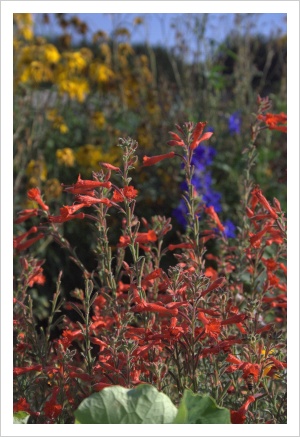 I grow seven different Humming Bird Trumpets (Zauschneria) in the garden. Their flowers stood up to the latest series of heatwaves better than any other and were fine even when the temperatures climbed to 40C. Most dry climate plants from California and adjacent states flower in the spring when there is a great deal of competition for the attention of pollinators. Zauschneria start flowering in late summer to coincide with the southern migration of humming birds.
I grow seven different Humming Bird Trumpets (Zauschneria) in the garden. Their flowers stood up to the latest series of heatwaves better than any other and were fine even when the temperatures climbed to 40C. Most dry climate plants from California and adjacent states flower in the spring when there is a great deal of competition for the attention of pollinators. Zauschneria start flowering in late summer to coincide with the southern migration of humming birds.
The tubular shaped, narrow throated flowers are a perfect shape for humming birds.
Whilst Humming Bird Trumpets grow happily in very dry areas in the wild I find that a little supplementary watering helps to keep them in good heart. They will survive very dry conditions but look much better for two or three good summer soaks. The cultivars with small, needle shaped silver leaves are the most drought tolerant, those with larger silver leaves close behind with the green leaved clones most in need of supplementary irrigation.
Botanists disagree on the number of species in the genus. This doesn’t matter to gardeners as long as the clonal names are consistent.
In our own garden we cut the plants down to near ground level in winter. We under plant with bulbs, mostly Alliums and Tulip species, which grow, flower and retire into summer dormancy before the Zauschnerias get going in mid-spring.
The only pest we’ve had is a caterpillar which a couple of years ago infested the new growth in large numbers. We drenched the plants with Dipel which is a biological control and poses no risk to people, bees or birds.
Zauschneria ‘Bowman’s ‘ was highly rated in the Rancho Santa Anna Zauschneria trials. It has 45cm tall twiggy stems clothed in narrow grey-green foliage. It is the earliest variety to flower producing its tangerine, flared flowers from mid-January. It is still showy in late April. ‘Bowman’s’ is thought to be a hybrid between Z. septentrionalis and Z. cana.
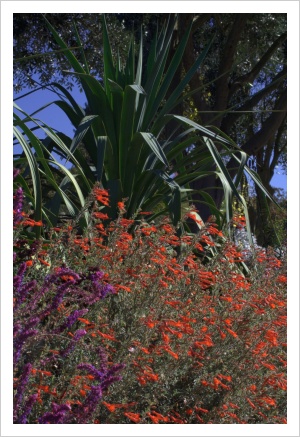 Zauschneria cana ‘Western Hills’ has been growing in our dry garden for many years and never fails to make a show producing its bright orange red trumpets on upright thin stems clothed in needle like grey green leaves.
Zauschneria cana ‘Western Hills’ has been growing in our dry garden for many years and never fails to make a show producing its bright orange red trumpets on upright thin stems clothed in needle like grey green leaves.
Z. cana ‘Albiflora’ needs more regular irrigation to do well. It fried when we planted it in a dry spot. It is now doing well in a new border in the vegetable garden where it is watered once a week during hot periods. It only grows 10 to 15cm tall but makes 50cm wide, dense mats of grey-green leaves. The white, flared, tubular flowers start in January and go on into April.
Z. cana ssp garrettii is a prostrate sub shrub making 10cm tall by 50cm wide mats of leaves more green than grey. This subspecies grows wild on dry inland Californian mountains. It does well here in our new Mediterranean garden producing its vermillion flowers from late January to March.
Z. cana ‘Catalina’ was collected in 1987 on Catalina Island which is off the southern Californian coast not far from Los Angeles. It’s a vigorous plant, the tallest variety we grow making 100cm and given time as much across. The foliage is intensely silver and the flared trumpets are bright orange red. It doesn’t start blooming here until the third week in February but goes on almost to winter.
Z. ‘Ed Carman’ has larger leaves than most. It does well in a border in the vegetable garden where it is regularly but grows near as well in a drier spots. ‘Ed Carman’, named for a famous Californian plantsman, grows 50cm tall by as much across and starts shows its flared tangerine flowers from early February until late April.
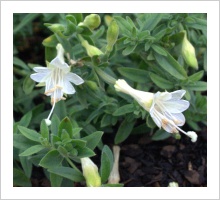 |
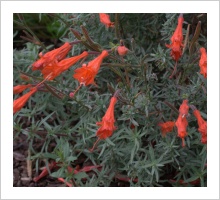 |
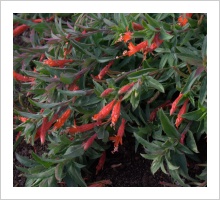 |
| Z. cana ‘Albiflora’ | Zauschneria ‘Bowman’s ‘ | Z. cana ssp garrettii |
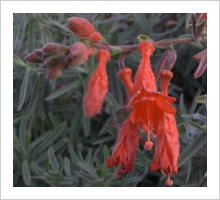 |
 |
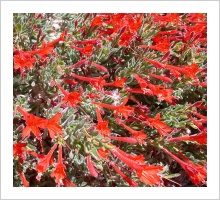 |
| Z. cana ‘Catalina’ | Zauschneria cana ‘Western Hills’ | Z. ‘Ed Carman’ |